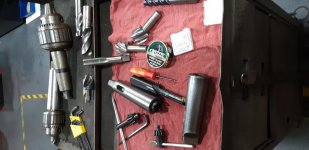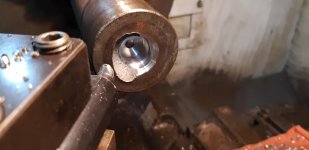These support pillars had a 1"-8 male thread sticking out about 2 1/2" that got broken off. I need to drill & tap 1"- 8 about 2" deep for a threaded stud as a (half assed) fix. The (not mine) idea was to weld up the hole so it could be faced off to have a flat surface to work off of. In theory it's a good idea but in this case now the glob of shit on the end is harder than a brick. I got one faced off and was able to center drill it but it just tore up the 7/8" drill as soon as it made contact. Tried getting underneath the hard with a 3/8" carbide 80deg diamond boring bar which worked some and I was able to suffer through one without tearing up too much stuff but they are still PITA.
They are about 3" round and about 4' long. I'd rather make new but that isn't my call. When all said and done it'd probably have been quicker. There are 8 of them 4 have been welded on before I got him stopped.
If it wouldn't walk all over the place plunging with a carbide end mill might help but all I have to hold it with is a drill chuck and 3/4" is as big as we have.
Wondering does anybody have any fantastic ideas for getting the these drilled & tapped?
It will be waiting on me when I get back tonight so I thought I'd run it passed you fellas to see what you've got to say. Thank you!
Brent
Edit: I don't know why the pictures are sideways?




They are about 3" round and about 4' long. I'd rather make new but that isn't my call. When all said and done it'd probably have been quicker. There are 8 of them 4 have been welded on before I got him stopped.
If it wouldn't walk all over the place plunging with a carbide end mill might help but all I have to hold it with is a drill chuck and 3/4" is as big as we have.
Wondering does anybody have any fantastic ideas for getting the these drilled & tapped?
It will be waiting on me when I get back tonight so I thought I'd run it passed you fellas to see what you've got to say. Thank you!
Brent
Edit: I don't know why the pictures are sideways?









